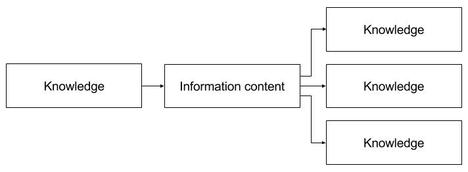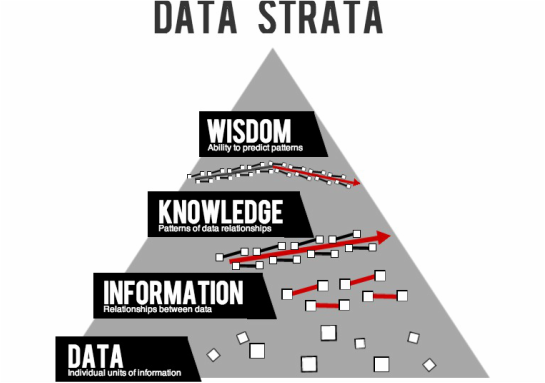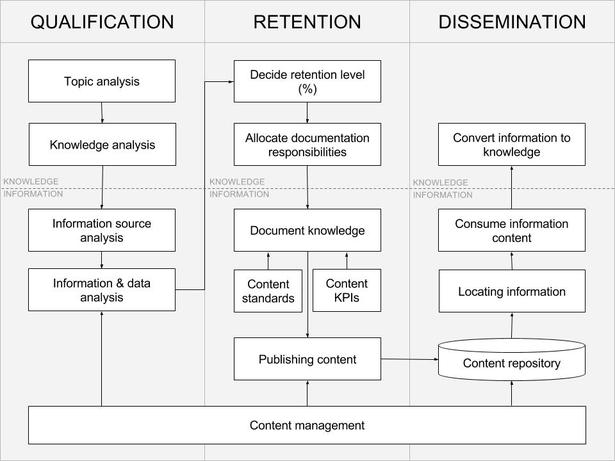Organisational Knowledge
Globally, modern organisations employ a ratio of knowledge workers to manual workers that has accelerated upward from 2:1 since the 1980s[1]. Knowledge as a business asset has never been a more valuable commodity in the private and public sectors than it is today.
Unfortunately for most organisations, staff turnover results in volumes of information walking out the door in the form of individual knowledge, with only a small percentage of it retained. Often attempts at organisational knowledge retention rely on reactive last-minute activities such as employee hand-over training or exit interviews.
This framework describes a complete information management methodology suitable for any organisation interested in converting the knowledge of individuals into organisational knowledge, and applying that asset to improve process efficiency, internal innovation, and day-to-day operations.
Knowledge only has value when it goes where it needs to be. This occurs through systematic knowledge sharing:
Unfortunately for most organisations, staff turnover results in volumes of information walking out the door in the form of individual knowledge, with only a small percentage of it retained. Often attempts at organisational knowledge retention rely on reactive last-minute activities such as employee hand-over training or exit interviews.
This framework describes a complete information management methodology suitable for any organisation interested in converting the knowledge of individuals into organisational knowledge, and applying that asset to improve process efficiency, internal innovation, and day-to-day operations.
Knowledge only has value when it goes where it needs to be. This occurs through systematic knowledge sharing:
Info management principles
This section discusses how information is classified, the different types of “info”, and the purpose and value of each type.
Understanding “info”
In order to design and manage an information system, definitions for types of information are required. To do so we refer to the hierarchy of information, illustrated below as the “Data Strata”. [2]
Understanding “info”
In order to design and manage an information system, definitions for types of information are required. To do so we refer to the hierarchy of information, illustrated below as the “Data Strata”. [2]
Data
A datum is an individual unit of info. Every datum consists of two components: context and value.
Examples of data:
Information
Information is the name for the relationships between data. A datum on its own does not convey enough meaning to be useful. Information occurs when data is arranged and combined in a way that creates connections between data.
Examples of information:
Knowledge
Knowledge occurs when patterns of data relationships are created. This is the sophisticated product of logic and reasoning, and happens naturally through the cognitive process when information is received in the brain, or in a computer through use of data input and algorithms. Knowledge is the ability to recognise patterns in information -- patterns in the connections between data.
An example of knowledge:
Once knowledge has been acquired (as in this example), a subsequent discussion on the topic of another sports car would mean that not only are this pattern of data is already known (and their values can easily and rapidly be learned) but the relevant connections between those data are already known, from which additional conclusions can be drawn once those data values are known. In this way, knowledge speeds up the information acquisition process because the only unknown is the relevant data-values; the data-context already exists in the known information pattern.
Wisdom
Wisdom is the ability to predict new patterns based on existing knowledge. This can occur by combining observable patterns in new ways, by generating new patterns, or by examining existing patterns with new perspectives. Wisdom can most simply be described as good judgement; it is the result of knowledge accrued by experience.
Examples of wisdom:
The primary difficulty of communicating wisdom is that, like knowledge, it must be broken down and conveyed as information or data, but also because it relies on pre-existing knowledge in order to be interpreted meaningfully. This management framework deals predominantly at the information and knowledge levels, and assumes (but does not require) a capacity for wisdom among the organisation’s members.
A datum is an individual unit of info. Every datum consists of two components: context and value.
Examples of data:
- Car colour: Red
- Car manufacturer: Ferrari
- Car owner: Kyle
- Car location: Dubai
- Owner location: London
- Days of ownership: 1
Information
Information is the name for the relationships between data. A datum on its own does not convey enough meaning to be useful. Information occurs when data is arranged and combined in a way that creates connections between data.
Examples of information:
- Kyle has owned a red car for one day
- The car is a red Ferrari
- There is a red Ferrari in Dubai
Knowledge
Knowledge occurs when patterns of data relationships are created. This is the sophisticated product of logic and reasoning, and happens naturally through the cognitive process when information is received in the brain, or in a computer through use of data input and algorithms. Knowledge is the ability to recognise patterns in information -- patterns in the connections between data.
An example of knowledge:
- Kyle is unable to drive his red Ferrari because he is in a different city to the car.
Once knowledge has been acquired (as in this example), a subsequent discussion on the topic of another sports car would mean that not only are this pattern of data is already known (and their values can easily and rapidly be learned) but the relevant connections between those data are already known, from which additional conclusions can be drawn once those data values are known. In this way, knowledge speeds up the information acquisition process because the only unknown is the relevant data-values; the data-context already exists in the known information pattern.
Wisdom
Wisdom is the ability to predict new patterns based on existing knowledge. This can occur by combining observable patterns in new ways, by generating new patterns, or by examining existing patterns with new perspectives. Wisdom can most simply be described as good judgement; it is the result of knowledge accrued by experience.
Examples of wisdom:
- Kyle is likely to have recently acquired formal ownership of his red Ferrari, but has not received the vehicle itself yet.
The primary difficulty of communicating wisdom is that, like knowledge, it must be broken down and conveyed as information or data, but also because it relies on pre-existing knowledge in order to be interpreted meaningfully. This management framework deals predominantly at the information and knowledge levels, and assumes (but does not require) a capacity for wisdom among the organisation’s members.
The Information Management Process
With the above definitions of the four levels of info now in place, the process for the framework comes next. This process is described below:
The process is divided (vertically) into 3 phases:
For full insight into this process and for a consultation to determine the value that this Organisational Knowledge Management Framework can offer to your organisation, enquire today at [email protected]
- Qualification, in which the information is examined as an asset to understand its value
- Retention, in which steps are taken to capture knowledge within the organisation in the form of information content, and
- Dissemination, in which information content is consumed and converted back into knowledge.
For full insight into this process and for a consultation to determine the value that this Organisational Knowledge Management Framework can offer to your organisation, enquire today at [email protected]
Citations
[1] Source: Fred Nickols, 2012 “The Shift from Manual Work to Knowledge Work” http://www.nickols.us/shift_to_KW.htm
[2] Alph Bingham describing these layers of information: https://www.youtube.com/watch?v=lLQURuOnBeI
[1] Source: Fred Nickols, 2012 “The Shift from Manual Work to Knowledge Work” http://www.nickols.us/shift_to_KW.htm
[2] Alph Bingham describing these layers of information: https://www.youtube.com/watch?v=lLQURuOnBeI




